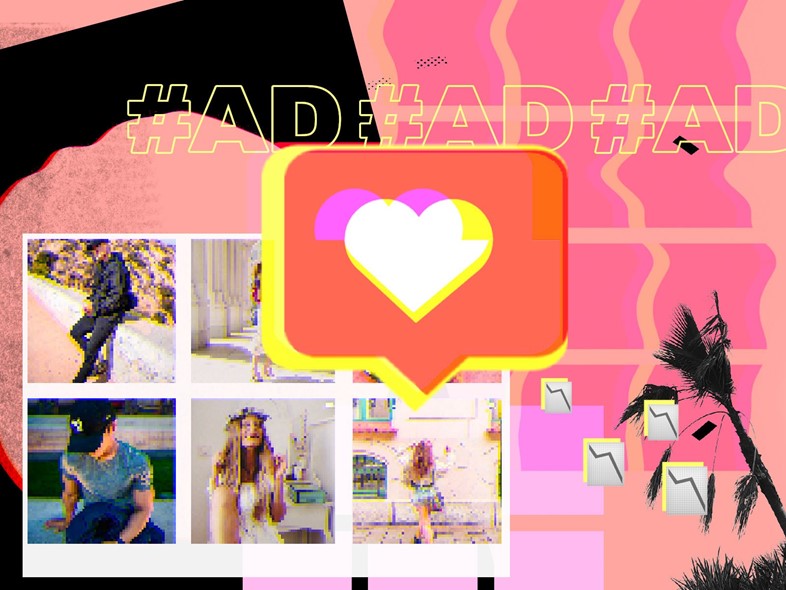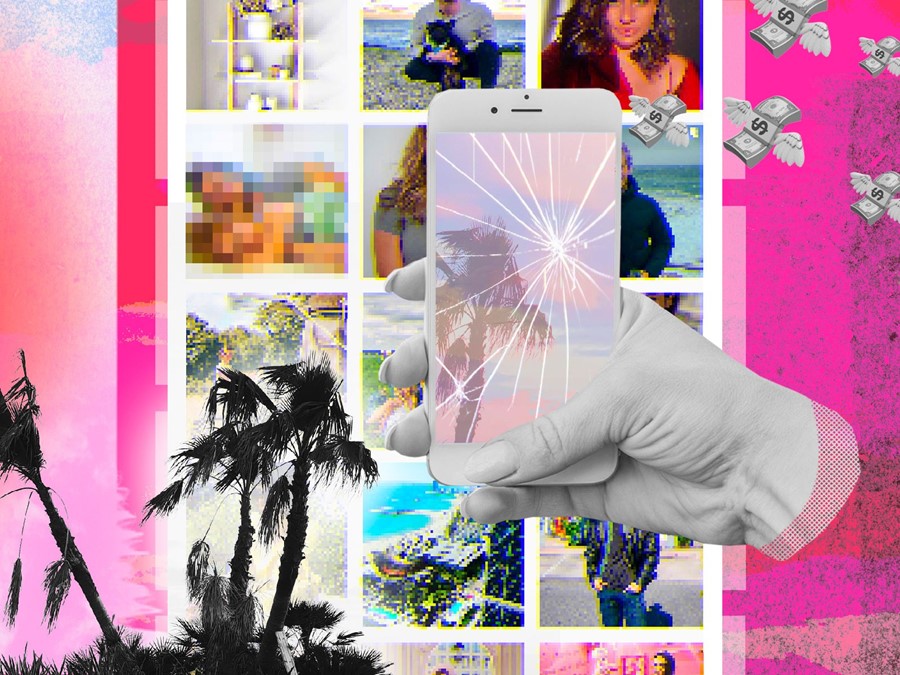Instagram is trialling removing likes, influencers are getting their arses out at Chernobyl, #ads are lowering engagement – what’s next for the divisive demographic?
Has the age of the influencer peaked? Once more niche than traditional celebrities, influencers are now completely ubiquitous – the word entered the dictionary last year, and beauty YouTuber James Charles prompted eyerolls by calling his invite to the Met Gala “a positive step forward for influencer representation”. They are everywhere, from Coachella to Chernobyl, Instagram to advertising agencies. While the engagement might look high, many believe that the bubble is finally bursting, and we’re just a bit tired of being influenced.
A recent report by Hypebeast found that influencers have increasingly less sway over their audience; one influencer opened up recently about selling just 36 shirts to her two million+ followers, and others are exposed daily for scamming their audience. Many of us are exhausted by the things that influencers once represented: millennial pink, inspirational quotes, tearful apology videos, ostentatious hauls.
Otherwise rational human beings seem to rabidly relish the end of influencer culture, partly because to some, it appears to be a lot of people rising to fame for doing “nothing”. We devoured stories about Fyre Festival because the idea of influencers trapped on an island with nothing to eat was irresistible to many who stopped just short of braying for the 21st century version of The Lord of the Flies.
We all know the images and tropes that we associate with influencers, but not that many people seem to understand what an influencer even is. Generally, it refers to anyone who uses their online image and brand to sell their audience something: whether it’s vitamins, clothing, or simply a lifestyle. Many of them will have a specialist skill or platform that they use to do that work: be it Instagram posts, vlogging, or blogging, their main graft is to be aspirational under the influencer umbrella. The term is still broad, encompassing everyone from Kendall Jenner, the highest paid model in the world, to Instagrammers with millions of followers but who nobody IRL has ever heard of.
So far, so similar to traditional advertising, whose job it also is to sell you a lifestyle. But where influencers differ to models or actors is that they ever seemed normal. Influencers are born from a DIY bedroom culture that, with technology we all have, allows them to reach millions of people. Some people feel uncomfortable with the apex of individualism and capitalism that influencers represent – we are supposed to believe they are both above us and the same as us at once. “With influencers, conversely, it feels like, with a little help and a little of their product, we could be (like them)”, wrote Naomi Fry for the New Yorker recently. The idea that “anyone can do it” draws people to influencers, but it also draws ire. Nobody likes the idea that just anyone can get plucked from a crowd of Instagrammers and be skyrocketed to fame: we like to believe there are set rules.
While claims that the era has peaked mostly come from critics, influencer culture does seem to be changing, with the parameters of their business changing rapidly. To understand that shift, Dazed speaks to people trying to work within it, like Tora Northman. Tora started out posting outfits, but soon saw her following grow to today’s 41k followers. She believes there’s been a big shift: “I used to follow countless bloggers and personalities, and many of them have become ‘irrelevant’ because of the abundance of new, younger people entering the industry.” She asserts that it has become easier to become an influencer, with brands tapping into so-called “micro-influencers” (with anywhere between 2k-50k followers) as the huge names become untouchable. “All you need is a phone and an Instagram account,” she says.
Amy Valentine, who’s been creating content since 2011 and now has almost 140k followers, has lived through a few eras in the industry, and at just 24, she confesses that the changes make her feel like a “dinosaur”. She doesn’t believe it’s all that easy to become an influencer: “just because you have ideas, doesn’t mean you also have the tactics to make them marketable. It’s also a brutal industry in terms of how it can affect your mental health.” Indeed, Instagram has been rated the worst app for your mental health. “Being an influencer is only so much of content creation as it is knowing how to handle brands, tailoring content for them and their goals, and just generally being business savvy. Markets need to be identified and targeted, you can’t just post photos and expect the followers to roll in.”
As the business of influencing has boomed, agencies have grown and formed to accommodate the change in how advertising works. Influencers who started in their bedrooms are now managed by PR teams and put in touch with opportunities by people like Maddie Raedts, the Founder and CCO of influencer marketing company IMA. She believes that a change has come from a backlash to perfect feeds: “People are looking for unique feeds – less polished, but much more real, interesting and artistique. This makes you stand out from the tough-to-beat algorithms these days,” she says.
She agrees with Tora’s comment on micro-influencers, telling Dazed that people want to “follow real, cool people, with a story to tell, a passion and a specific talent they have or own, not the same thing over and over again.” The Atlantic recently wrote that the curated aesthetic we associate with Instagram is over, with younger influencers capitalising on a more “real”, less obsessively planned feed.
“Maybe we feel weary of influencer culture because we just don’t want to see aspirational content anymore”
Maybe we feel weary of influencer culture because we just don’t want to see aspirational content anymore. We don’t want to be told how to live, what to wear, what festivals to attend, what tea to drink. Maybe we don’t want to be always on, always hustling, always making content. Are we entering a culture of radical laziness? Quartz wrote that it’s time for “the slacker to rise again” and other outlets have touted the benefits of laziness.
The mantra of obsessive self care, home organisation, and “having it all together” that influencers once pushed is no longer what we want to see. Minimalism is having a moment, with pushback from the inside against the materialism that vloggers used to inspire with their “haul” videos. Influencers are adapting, pushing sustainable alternatives rather than spending hundreds in Primark for monetised clicks. When aesthetics and trends that used to work for them die out, savvy influencers evolve.
On Instagram and YouTube, influencers are facing criticism for the products they’re willing to shill: many young women cut their teeth pushing dangerous “skinny teas”, but that is now unacceptable. We’ve started to ask for responsibility: for influencers to think about their “influence”, and to not push harmful products on impressionable teens. When they start out, influencers are unprotected by the PR teams that bigger celebrities have, and that leaves them open to criticism and “cancellation” on an unprecedented scale. The thing that sets them apart also leaves them vulnerable.
Many influencers are even quitting the industry. Tara Costello, a blogger who quit because among other things, tells Dazed that she didn’t like the way the “industry was heading” or what it was bringing out in her. She said it had a huge impact on her mental health: “My experiences in general were more negative than positive. There’s a lot of social climbers in the industry and a hell of a lot of subtweeting going on, and I definitely got caught up in all that for far too long. Not only that, it’s really easy to compare yourself people with bigger platforms than you and feel bad about yourself.” She said, adding that the insidious “lack of transparency” in the industry also contributed to her decision.
“My experiences in general were more negative than positive. There’s a lot of social climbers in the industry and a hell of a lot of subtweeting going on, and I definitely got caught up in all that for far too long” – Tara Costello, former infuencer
The push towards responsibility and transparency has meant that, according to Eric Dahan, the CEO and co-founder of Open Influence, influencers now have to be more “professional”. He says, “certain standards and norms have come into place”. This shift has affected not only the way we see influencers, but the way they can do their work. Partnerships used to be simple: an influencer would post an outfit on Instagram, naming the brand, and their audience would, hopefully, buy them. The idea was that a “non-celebrity” young woman with hundreds of thousands of followers was capable of pushing products organically; that their audience was more likely to be receptive, as if they were being offered makeup and skincare by a friend.
That’s changed: following new rules, influencers now have to tag their posts with “AD” and “GIFTED” and make it clear they didn’t choose to pay for it. That transparency makes the advertising more responsible, but it takes away from what made it work: that it seemed like it wasn’t advertising at all. Tora told me that she’s really selective with sponsored posts as she’s afraid “that things won’t seem authentic if it’s constantly tagged as ‘ad’ or ‘gifted’”.

Flo Guan, who never set out to be an influencer but currently has over 120k followers from posting outfit photos, now models for brands like Cyberdog and Motel Rocks. She says that she understands why these rules have been set: “It’s better for the consumer so that they know which products have been promoted because they’ve been paid and which products they have been given for free”. She believes that influencers have a responsibility to their audience: “Some products or services are bad for you, such as ones that make young girls alter their body image.”
Amy says that while she’s always been transparent, the new rules are “tight” and confusing, as she now has to say “AD” even if she just happens to be wearing shoes that she got for free. She says that there’s a lot of stigma around posting ads, and that she’s lost followers for paid content, even though it’s the only way influencers really have to make money from their work. “Personally, I will never work with a brand that I wouldn’t purchase from myself, and as a result of this I have lost business, but it means I retain integrity”, she says.
“The space has completely professionalised. We often used to refer to it as the Wild West,” says Chelsea Carter, Head of Content at an agency called Whalar. While regulation has made the space more transparent and professional, the shift is partly down to influencers themselves. YouTubers will now regularly open up about their flaws, their mental health issues, their financial difficulties, although critics argue that this is simply a way of latching onto self-care narratives in order to diversify revenue streams.
YouTuber Gabbie Hanna recently staged her entire attendance at Coachella in an effort to shed light on just how easy it is to fake things online, but she doesn’t seem to be giving up influencing anytime soon.
These shifts could look to some like influencers are headed for extinction, but it seems more likely that the industry and its “employees” is simply evolving, and the smartest influencers are learning to evolve with it. As a brand new business that wasn’t possible five or ten years ago, it’s constantly changing. With the expectations for influencers ever-changing and social media platforms regularly shutting down, the situation seems unstable for those who make it their living. If Instagram dropped likes, as it often considers trialling, it would massively affect how influencers track their engagement and explain their worth to prospective clients, or even their audience. Amy tells me that the algorithm shift has dragged her reach down to 13-15 per cent, leading her to feel like her hard work has been “wasted”. How is it possible to plan for a career or a future when you’re beholden to the constantly changing strategies of enormous tech companies?
With influencers seemingly at the whim of platforms, I asked Tora whether or not she thinks being an influencer could ever stop being possible: “I think the whole ‘influencer industry’ has caused a lot of stress and a lot of unrealistic expectations for kids and teens all over the world, and I would like to see it either disappear or drift into something more empowering”, she says. Despite that, she doesn’t think it will happen: “If Instagram shuts down, there will be another platform that everyone will navigate to”. Flo agrees: “Everyone would just move onto and adapt to the next platform.” Amy believes that influencers aren’t going anywhere, citing famous Viners’ migration to Tik Tok and YouTube as an example of their adaptability.
“I think the whole ‘influencer industry’ has caused a lot of stress and a lot of unrealistic expectations for kids and teens all over the world, and I would like to see it either disappear or drift into something more empowering” – Tora Northman, influencer
For influencers themselves, these changes will only mean extinction if they aren’t adaptable. That means that more and more of them are seeking out ways to “future-proof” themselves and take on more traditional streams of income. Tora, who works for women’s streetwear website Hypebae full time, says that future-proofing is important to her because she “never wants to become known as an ‘influencer’”. She sees her side hustle as an influencer as less of a job and as more of a fun creative outlet “which happens to sometimes make me some money”.
Flo, too, tries not to rely on Instagram, doing modelling, freelance graphic design, and selling clothes on the side to secure an income. Amy says that while she currently doesn’t need another job, she has side hustles in the pipeline to ensure her stability: “The long term goal is to stay self-employed, and I feel that with my understanding and experiences within the industry, I could venture into managing other influencers”, she tells me.
Critics of influencers often forget that the people in that world have more criticisms of it than they do. But as with any industry or movement, people will hear from the loudest, most controversial voices. Tora said: “I think there are a lot of shitty influencers out there. People get a following and all of a sudden think they are celebrities and that they can get any job in the world, but that’s not reality. I think they’re the ones that have made people frown upon the whole influencer industry.” These influencers only harm the ones who are transparent and try to use their platform to help brands and spread a good message. “With factors like abortion laws and the Earth literally dying as we speak, suddenly all these influencers with millions of followers have nothing to say,” says Amy.
“With factors like abortion laws and the Earth literally dying as we speak, suddenly all these influencers with millions of followers have nothing to say” – Amy Valentine, influencer
Tora believes that the criticisms, while often fair, come from a confusion about just what being an influencer is. It’s brand new, and many question its validity: “A lot of people don’t view it as a career, but I think that comes from an old-school mindset where a nine-to-five job has always been the norm.” Amy says that she understands the shit influencers tend to get: “These people get free clothes, holidays, get to hang with celebs, experience things that money can’t buy, and all just because they do their makeup on camera?”
Influencer culture hasn’t yet peaked, it’s just evolving as rapidly as it was born. Influencers are adaptable: many of them jumped on the culture before it was even profitable, and successful ones will move to new aesthetics, trends and platforms when the ones that were working die. Long before this era, shifts imperceptible to those on the outside have already changed many influencers’ careers dramatically, but as their culture is pushed to the mainstream, people are watching to see them fall. Influencers who adapt to an ever-changing culture while future-proofing themselves against Instagram’s inevitable demise are the ones who will thrive, but regardless, there will always be people claiming that their time is up.




